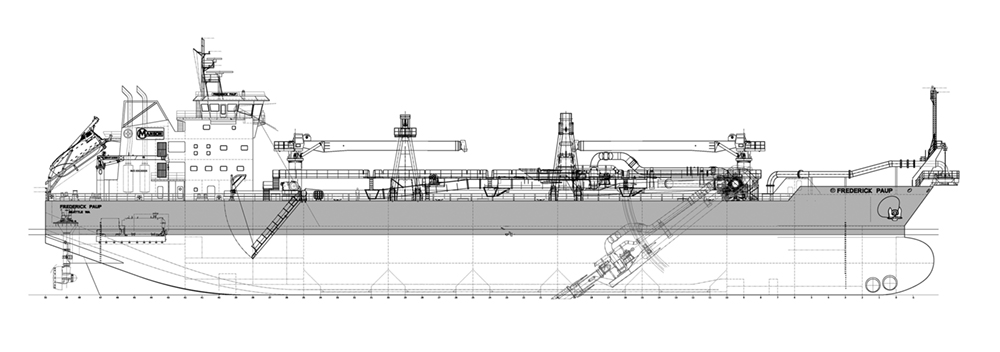By Peter Marsh

Manson Construction Co. of Seattle was established in 1905 by an enterprising Swedish immigrant and since the 1980s, the company has built or converted several trailing suction dredges designed by the Hockema Group that have set standards for capacity in their class, from the 265-foot Newport, with a hopper capacity of 4,000 cubic yards, to the 390-foot hopper dredge Glenn Edwards, launched in 2006 with a hopper capacity of 13,700 cubic yards.
By 2008, Manson Vice President Henry Schorr was discussing the possibility of a bigger and more efficient version of the Glenn Edwards. This led to a decade of research and planning led by a 10-person team of company experts who met regularly to develop this concept and consider the suggestions of Manson’s crews.
In 2018, the management finally contracted with Hockema to begin work on the detailed design of the new dredge, to be named the Frederick Paup after the chairman of Manson’s board of directors.
With a length of almost 420 feet, a beam of 81 feet, and a depth of hull of 32.5 feet to the main deck, the hopper capacity will be over 15,000 cubic yards, making it one of the largest US-flagged, self-propelled hopper dredges in the nation, according to Hockema.
In contrast to the Glenn Edwards, which is powered by a total of 15 diesel-electric generators and propulsion by three azimuth drives, the Frederick Paup is designed to be the company’s first vessel with a modern fully-integrated diesel-electric power plant with a total of five powerful Tier 4 diesel generators, compared to the 15 diesel engines on the Glenn Edwards.
This system would be able to produce the precise amount of electric power required to meet the demands of the ship in any operational mode, resulting in easier maintenance, reduced engine hours, and lower fuel consumption. It would also centralize all the engine room systems, including cooling, exhaust etc. housed in the superstructure at the stern, below the accommodation block.
(Note: Manson has not publicly revealed the manufacturer, output of the engines, or other technical details of the vessel.)
The partnership between Manson and Hockema has also produced other breakthroughs in engineering with improvements and updates in almost every area of hopper dredge technology, according to Hockema, particularly in efficiency, automation, safety and power versatility.
“Our electrical engineering team designed the complete electrical system which is distributed throughout the vessel spaces, but was not responsible for the power management system. This is primarily software driven and not centralized in physical equipment,” explained Michael Minnig, P.E., vice president and senior principal with Hockema Group.
“There will be certain physical electrical panels, sensors, power meters, etc. integrated into the entire setup, but the value is that all dredging controls can be operated from the dredge-tender’s station in the pilot house,” he pointed out. “This should allow full operation with one engine offline and significantly increase reliability and reduce man hours.”
The navigating station on the pilot house deck is designed to have 360‐degree visibility for safe operation in shipping channels and a clear view along the working deck that holds the dredging gear. All operations would allow for remote controlled from the deck at the drag-tender’s station, including operating the dual drag arms, which are now electrically-driven, along with the numerous winches, davits. The main deck layout allows the crew to pass through a passageway with no obstructions or steps and to easily inspect the bow discharge point.
Hockema developed its signature hopper dredge hull form to maximize the hopper capacity. The bow shape and stern lines with the skegs and three z-drive pods were then refined to reduce hull resistance in both the loaded and unloaded conditions using Computational Fluid Dynamic (CFD) analysis. Modifications to the original hull form reduced resistance by almost 20% in the loaded condition and over 10% without load, according to Hockema.
The reinforced working deck is structurally important as an integral part of the hull’s girder strength, which is necessary to handle the huge stresses imposed by a full load of dredge spoils.
Dredged material can be emptied by either bottom-dumping through five pairs of dump doors located at the bottom of the hopper, or by “slurifying” the load with the jet-water piping and pumping out over the bow to a floating discharge hose for distribution near shore, or spraying out of a large nozzle — sometimes referred to as “rainbowing.”
A hopper dredge works in very abrasive field, where maintenance dredging, channel cutting and beach nourishment all require the right equipment. Minimum downtime for repair and replacement of all machinery in contact with dredge material environment was considered, according to Manson and Hockema, and will be facilitated with large hatches permitting crane access to reduce time needed for gear replacement.
Hockema’s staff used 3D software to model the pump room and pump-off suction manifold to ensure an efficient layout. All the dredge pumps and suction manifolds are designed to be isolated from the electric drive motors, switchboards and other electrical equipment by a watertight bulkhead.
“Our focus at HWMA is to ensure that the Frederick Paup will be a major force in the dredging market for decades to come,” said Minnig.
The Frederick Paup is now under construction at Keppel AmFELS in Brownsville, Texas. The new dredge will be fully classed by the American Bureau of Shipping, according to Manson, and is expected to receive ABS A1, AMS, and ACCU class notations as well as SOLAS (Safety of Life at Sea) certification. It is expected to enter service in 2023.
